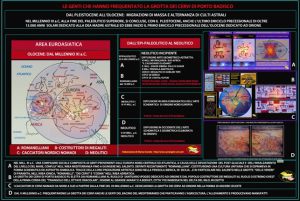
In 2021 the locality of Porto Badisco in the Otrantino attracted public attention for the calamities that affected it: a vast fire that last summer destroyed the vegetation of the surrounding greenhouses and in autumn an unexpected flood, which canceled its small but well-known beach.
The recurrence, on February 1, 2022, of the 52nd anniversary of the discovery of the Grotta dei Cervi; the karst cavity that runs through the hill adjacent to the river groove affected by the torrential waters on November 18, 2021, cannot go unnoticed, especially because the Romanellians, twelve thousand years ago, coming from the Franco-Cantabrian area and first executors of black-figure pictograms, arrived in the Salento area favored precisely by the rising sea waters and the post-glacial river routes that crossed the continent, such as those that connecting the Tyrrhenian with the Ionian made them reach the Gulf of Taranto more easily than today and thus easily land in Salento.
Many of those European rivers have now disappeared, dried up in the temperate phase of the Holocene, while at the time they were well supplied with water due to the melting of the Würm glaciers.
Geomorphological aspects
 The scenario that occurred in Porto Badisco in November 2021 after a night of torrential rains has restored a typical condition of a post-glacial landscape, filling the bed of an ancient river course coming from Minervino and a retro-dune basin, reclaimed over the years Thirties of the twentieth century, before flowing into the sea in the area of the well-known beach.
The scenario that occurred in Porto Badisco in November 2021 after a night of torrential rains has restored a typical condition of a post-glacial landscape, filling the bed of an ancient river course coming from Minervino and a retro-dune basin, reclaimed over the years Thirties of the twentieth century, before flowing into the sea in the area of the well-known beach.
Once again the town of Porto Badisco makes us reflect, not only on our history and our culture, but also on the environmental condition of Salento, re-proposing on a smaller scale what happens in the world in our era called “Anthropocene”.
Porto Badisco and its cave
For this reason I believe I can make a reference to the contents of what was already published here in 2009 and then re-proposed in the series dedicated to the Discovery of Salento starting from 19 July 2020, with articles entitled “Geomorphology and karst”. The topics covered were and are aimed at getting to know our territory starting from its stone structure; and the importance that its predominantly flat configuration assumes in monitoring the consequences of phenomena due to this particular intermediate and unstable climatic phase.
Oscillating predictive aspects
For scientists engaged in formulating predictive models in the field of climatology, seismology, volcanology, i.e. in the context of all the exogenous and endogenous aspects that affect the Earth; in addition to the evaluation of the natural tendency, which should lead the planet to cooling gradual due to the retrograde transition to the millennial season of the precessional winter, it is necessary to add all the disturbing parameters due to human intervention, which interfere, locally and globally, with the natural planetary dynamics and therefore propose geological, hydrogeological solutions , Anti-seismic … repairing and preventive.
This complexity of factors today makes the climate more widely oscillating between the limits of the maximum summer temperatures, which favor the rapid spread of forest fires and the accentuated evaporation of water, and those of the minimum temperatures which rapidly and intensely lower the climate of some places in the planet.
Among the most urgent interventions at the local level, there is the drainage of large areas of impermeable terraced marine deposits and the rehabilitation of those habitats that the alluvial and torrential character tends to overwhelm.
(articles from October and November on karstification in geomagnetic cells)
Globally, these phenomena and the pouring into the sea of melting fresh waters from polar and continental glaciers also contribute to reducing the salinity of marine waters. The expected considerable rise in the level of the oceans reduces the coastal areas; erasing the beaches and causing the cliffs to collapse and, at the same time, allows the salt water to rise along the river courses, making the fresh water of the aquifers brackish, necessary for the vital supply. water supply of man.
A project aimed at making the flux waves of destructive electromagnetism coherent, which increases the opening of the faults and causes the cliffs to collapse, which could cause earthquakes and consequent tsunamis, could mitigate the risks due to the excess of electromagnetism produced by the planet’s core. ; subject to greater effort in moments of marked inclination of the earth’s axis, which gives large fluctuations to its “spinning top effect”.
The reduction in the degree of salinity of marine waters can be controlled and mitigated by draining the beds of large rivers and regularly and gradually freeing their mouths from the amount of accumulated debris.
Large masses of freshwater discharged violently into the sea can, as has already happened in past eras, rapidly inhibit the activity of the “conveyor belt of the deep waters of the oceans”, that is, that “biological pump” that ensures the planet a temperate climate, consequently leading it to an alternate and anomalous phenomenon of non-gradual freezing.


